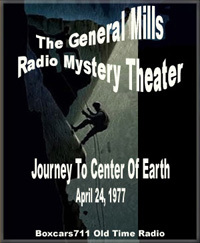
Journey To Center Of Earth (Aired April 24, 1977)
The series had it origins in the meeting of two minds: the ad agency for General Mills at the time, Dancer-Fitzgerald-Sample was looking for a different means to reach a child audience besides television, which was decreasing commercial minutes and increasing costs; and Himan Brown, producer-director of the CBS Radio Mystery Theater, who wanted to introduce new audiences to the dramatic form on radio. Tom Bosley was chosen as the host because of his television recognition from a kid’s oriented series, Happy Days. CBS chose to produce 52 original broadcasts followed by 52 repeat broadcasts. I believe they had hoped to maintain General Mills sponsorship during the complete 104 episodes, but General Mills dropped their sponsorship after the original broadcasts. The series continued for the next 52 repeats as the CBS Radio Adventure Theater.
THIS EPISODE:
A Journey to the Centre of the Earth (French: Voyage au centre de la Terre), also translated as A Journey to the Interior of the Earth, is a classic 1864 science fiction novel by Jules Verne. The story involves a professor who leads his nephew and hired guide down a volcano in Iceland to the "centre of the Earth". They encounter many adventures, including prehistoric animals and natural hazards, eventually coming to the surface again in southern Italy. The living organisms they meet reflects the geological time; just as the rock layers become older and older the deeper one gets, the animals get more and more ancient the closer the characters come to the center. From a scientific point of view, this story has not aged quite as well as other Verne stories, since most of his ideas about what the interior of the Earth contains have since been proven wrong. However, a redeeming point to the story is Verne's own belief, told within the novel from the viewpoint of a character, that the inside of the Earth does indeed differ from that which the characters encounter. One of Verne's main ideas with his stories was also to educate the readers, and by placing the different extinct creatures the characters meet in their correct geological era, he is able to show how the world looked like millions of years ago, stretching from the ice age to the dinosaurs. The book was inspired by Charles Lyell's Geological Evidences of the Antiquity of Man of 1863. By that time geologists had abandoned a literal biblical account and it was generally thought that the end of the last glacial period marked the first appearance of humanity, but Lyell drew on new findings to put the origin of human beings much further back in the deep geological past. Lyell's book also influenced Louis Figuier's 1867 second edition of La Terre avant le déluge which included dramatic illustrations of savage men and women wearing animal skins and wielding stone axes, in place of the Garden of Eden shown in the 1863 edition.
FOR THIS EPISODE AND HUNDREDS MORE, FOLLOW THIS LINK TO BOXCARS711


No comments:
Post a Comment